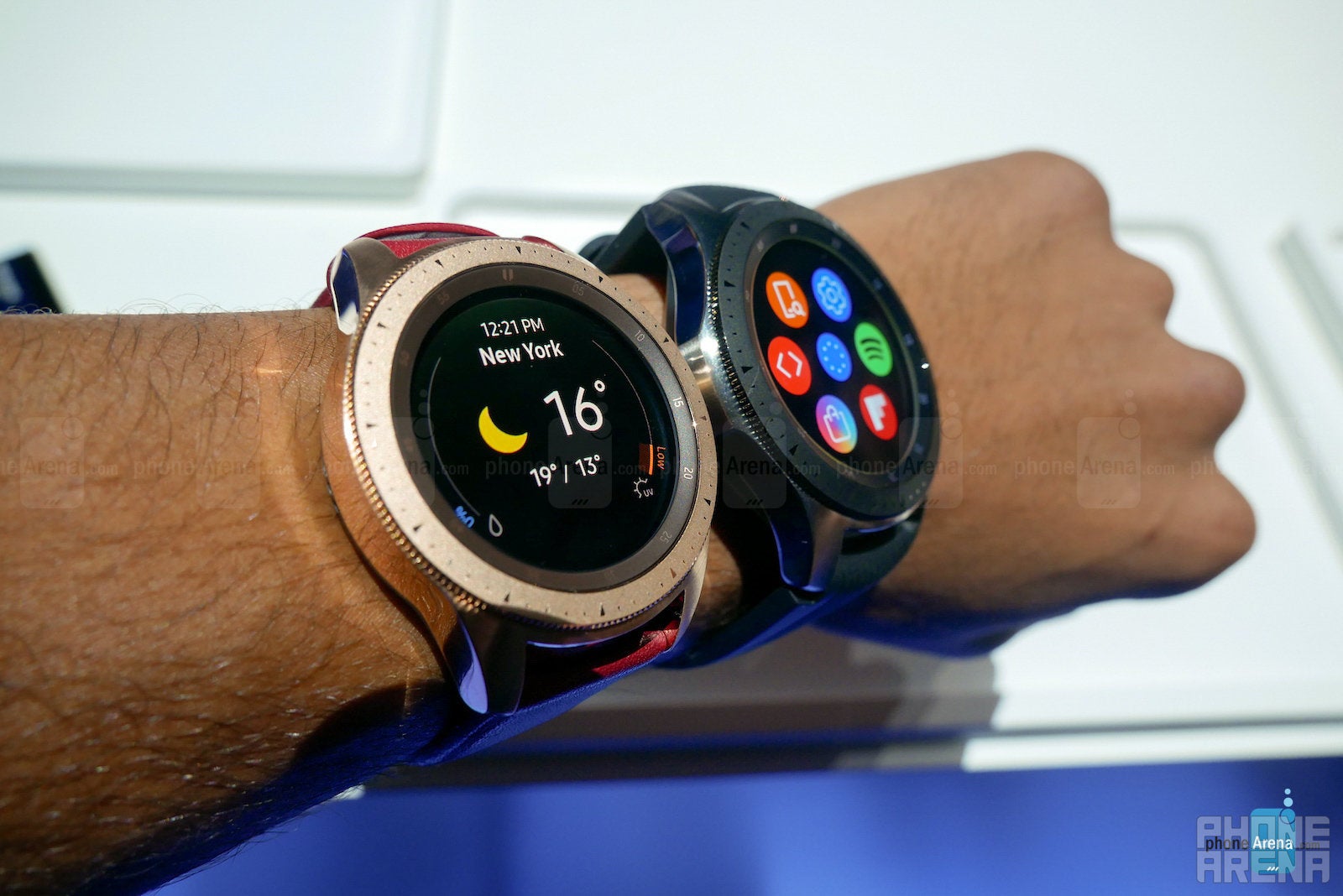Today Samsung held their 2018 Unpacked event, and, as anticipated, the Galaxy Note 9 was announced in all its glory. What we didn’t see coming, but genuinely hoped for (for over a year now) is the announcement of a proper successor to the Galaxy Gear S3 – the newly, more simply put Galaxy Watch. We got some time with this new device and, really, we’d be bad people to not share that experience with you. So, here you go!
Design and Display
The Samsung Galaxy Watch is a more refined looking piece of hardware than the Gear S3, much like the Samsung Gear Sport, which was introduced last year around this time. While the Gear Sport had a more angular design, the Galaxy Watch goes back to the circular shape of the Galaxy Gear S3, but with finer teeth cut into the rotating bezel, lending itself to an overall aesthetic that comes off less like gear, and more like a watch.
The Galaxy Watch comes in two sizes: 42- and 46-mm watch faces, with 20- and 22-mm watch bands, respectively. The 42mm version will be available in rose gold and black, while the 46mm variant only comes in silver. All models are 5 ATM waterproof (safe to submerge in up to 50 meters of water) sport 360 x 360 px Super AMOLED displays which look bright and sharp; we had no issues reading their screens under showroom lights, but sunlight will be the proper test – one in which we anticipate the Galaxy Watch will do well. Overlaying Corning DX+ glass, a formula made specifically for smartwatches, should also aid in clarity, as well as scratch resistance.
Processor, Performance, and Battery Life
In theory, it shouldn’t be too hard to make a smartwatch that zips along in everyday use, but there is a delicate balance to strike – one that considers heat, quickness, and, of course, battery life. Samsung’s done some work to specifically address battery life on the Galaxy Watch; heat and speed will have to be better surmised over time, but initial impressions are good – light and zippy.
Creating their own smartwatch-specific processor, the Exynos 9110, Samsung has been able to promise multiple-day battery life in the right conditions. Quoted at up to 168 hours (7 days) for the 46mm model and 120 (5 days) for the 42, these numbers, at a glance, will fill smartwatch fans with joy, but, of course, factors like LTE, Wi-Fi, signal strength, and the always-on display will significantly affect these estimates. Still, if the Galaxy Watch can last more than a day with average use, that will be some cause for celebration.
Interface
Built with Samsung’s unique and efficient Tizen OS within, the Galaxy Watch utilizes the satisfying and easy-to-use rotating bezel for navigation, but, just as in the past, you can swipe through the OS to get around, as well. Movement through the OS seems fluid and prompt, and the rotating bezel is just as smooth and satisfying to use as ever.
Samsung’s always had an affection for health-tech and the Galaxy Watch carries on that tradition. As always, sleep tracking is built-in, as is tracking for exercise, but the latter has been expanded to include heart rate and workout information for 39 different exercises – 6 of which are automatically detected.
Also detected are your stress levels based on your heart rate. Over time the Galaxy Watch can monitor your heart rate and offer you breathing exercises when it “senses” that you’re stressed out, based on your average trends.
Spotify integration, via Samsung’s partnership with the streaming music service, should also lower your stress levels, as you can now stream and download Spotify music directly onto your Galaxy Watch’s 4 gigabytes of storage.
Lastly, and perhaps also to lessen (or perhaps increase) your stress, you can access Bixby via the Galaxy Watch to make tasks even easier with voice commands. Samsung and Spotify have said Bixby control of music streaming is forthcoming for phone, so hopefully Galaxy Watch users can bask in this glory, as well.
Connectivity
Samsung’s also introduced a new wireless charger, called Duo Charger, which can power up your Galaxy phone at the same time as your Galaxy Watch.
Samsung worked with 30 carriers in 15 different countries to make the Galaxy Watch compatible with cellular data. 4G LTE capability is a nice cherry on top of all of this so that you may truly leave your phone at home when going for a run, hike, or trip to the gym. In the U.S., these versions will be launched through Sprint, AT&T, T-Mobile, and Verizon at later dates, while Bluetooth-only variants will be up for pre-order on August 10th, with a release date of the 24th – same as the Note 9.
Expectations
The Bluetooth-only Samsung Galaxy Watch is priced at $329.99 for the 42mm and $349.99 for the 46. Pricing and availability are to be announced, likely by the carriers, for LTE versions. The pricing of these formidable smart watches seems quite reasonable, especially considering the starting prices of similarly equipped Apple Watches, and even Android Wear devices with less capability. Tizen and the smooth rotating bezel have been a winning combination for Samsung in the past, and if multiple-day battery life can stand the test in real life then this, paired with 5 ATM waterproofing and LTE might make this Galaxy Watch the one many have been waiting for.
















Things that are NOT allowed: